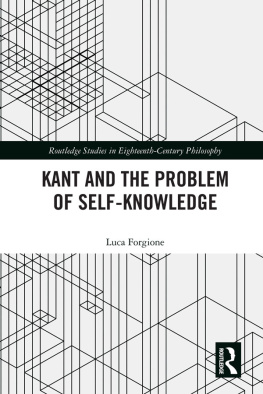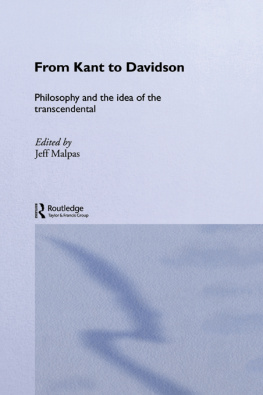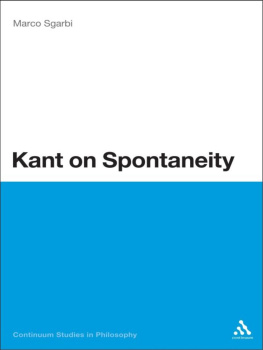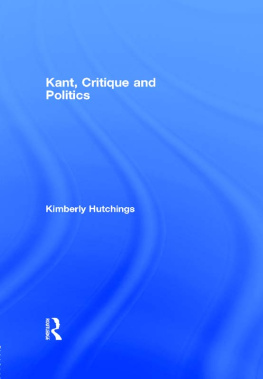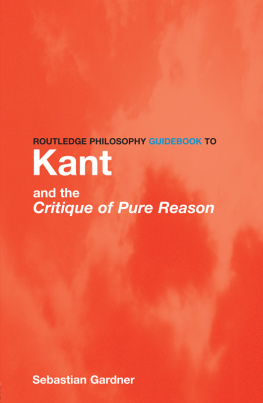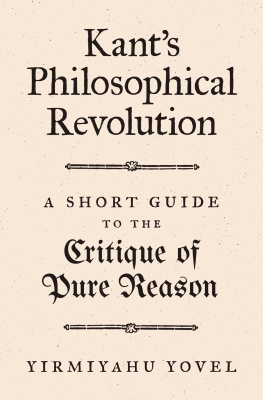Space, Geometry,
and Kant's Transcendental
Deduction of the Categories
Thomas C. Vinci
- Oxford University Press is a department of the University of Oxford.
- It furthers the Universitys objective of excellence in research, scholarship,
- and education by publishing worldwide.
- Oxford New York
- Auckland Cape Town Dar es Salaam Hong Kong Karachi
- Kuala Lumpur Madrid Melbourne Mexico City Nairobi
- New Delhi Shanghai Taipei Toronto
- With offices in
- Argentina Austria Brazil Chile Czech Republic France Greece
- Guatemala Hungary Italy Japan Poland Portugal Singapore
- South Korea Switzerland Thailand Turkey Ukraine Vietnam
- Oxford is a registered trademark of Oxford University Press
- in the UK and certain other countries.
- Published in the United States of America by
- Oxford University Press
- 198 Madison Avenue, New York, NY 10016
- Oxford University Press 2015
- All rights reserved. No part of this publication may be reproduced, stored in a
- retrieval system, or transmitted, in any form or by any means, without the prior
- permission in writing of Oxford University Press, or as expressly permitted by law,
- by license, or under terms agreed with the appropriate reproduction rights organization.
- Inquiries concerning reproduction outside the scope of the above should be sent to the
- Rights Department, Oxford University Press, at the address above.
- You must not circulate this work in any other form
- and you must impose this same condition on any acquirer.
- Library of Congress Cataloging-in-Publication Data
- Vinci, Thomas C., 1949
- Space, geometry, and Kants transcendental deduction of the categories / Thomas C. Vinci.
- pages cm
- Includes bibliographical references and index.
- ISBN 9780199381166 (hardcover : alk. paper) 1. Kant, Immanuel, 17241804.
- Kritik der reinen Vernunft. I. Title.
- B2779.V56 2014
- 121dc23
- 2014007456
- 1 3 5 7 9 8 6 4 2
- Printed in the United States of America
- on acid-free paper
Dedication
(p.v) To my late mother, Ellen Suzette Vinci (ne Auerbach), and father, Ernesto Vinci (n Wreszynski).
It ended well. (p.vi)
(p.xi) Acknowledgments
I would like to thank the De Gruyter Press of Berlin for permission to use material from an article, Solving the Triviality Problem in the B-Edition Deduction, first published in Kant und die Philosophie in weltbrgerlicher Absicht I (October 2013), 471482.
I would also like to thank those many Kant scholars whose support in conversation and correspondence has helped a great deal in the thinking that went into this book and the actual writing of it, including Henry Allison, Karl Ameriks, Nathan Bauer, Jeff Edwards, Lorne Falkenstein, Paul Guyer, my Dalhousie colleague Michael Hymers, Robert Howell, Batrice Longuenesse, and especially Richard Aquila. Thanks also to an anonymous referee for Oxford University Press.
I am also indebted to the members of my department, especially those who have come to hear me talk about Kant in numerous colloquia during the last twenty-five years as this project slowly came to fruition. Their comments helped immeasurably to shape my understanding of Kant and of philosophy. Much of the fundamental thinking about Kant that went into this book originated in preparing my courses on Kant over that period, and so I also owe much to the students who attended the lectures and shared their ideas with me.
Most recently, I am indebted to my friends, colleagues, and students at Tel Aviv University, where I presented an earlier draft of the manuscript to students in a graduate seminar. I wish to thank those who attended the seminar, especially Nir Friedman, Ori Rotlevy, and Nadav Rubenstein. I also wish to thank my friend Noa Naaman-Zauderer and the chair of the department, Eli Friedlander, for inviting me to come to Tel Aviv.
I single out for special mention the Israeli Kant Group and its organizer, Ofra Rechter, for inviting me to present on May 10, 2013, material from an earlier draft of the chapter on Kants theory of geometry (Chapter philosophical dialogue about my work on Kant, an intellectual highlight of not only my visit to Israel but of my entire philosophical career. Thanks to you all. Thanks also to Judith Sidler and my other friends and colleagues in the German Department.
Finally I wish to thank Peter Ohlin, the editor for Oxford University Press who managed the refereeing and acceptance procedures for the manuscript and saw it through the press. The presentation of the text owes much to an excellent copy editor, Thomas McCarthy and indexer, Diane Barrington. Thanks also to Emily Sacharin and Geetha Parakkat, so pleasant and easy to work with, who organized various stages of the publication process.
Introduction
In section 5 of the Discourse on Metaphysics Leibniz explains to his readers the sense in which the actual world is the best of all possible worlds: it is the best of all possible worlds because it optimizes two values: the simplicity of the means and the diversity of the effects. In this case the means are the laws of nature and the ends are the number of different natural kinds in nature. Leibniz attempts to explain the notion of optimization by a number of examples; perhaps the most effective is that of an author of a treatise who seeks to optimize the values of brevity in the number of sentences and extensiveness in the number of truths. This example makes it clear that Leibniz is not talking about maximization of each value independently of the other, for that could be done in a book of one sentence, if the goal was to maximize brevity, or infinitely many, if the goal was to maximize the extensiveness of the number of truths. But maximizing any one of these values minimizes the other, so the problem is to explain a sense in which there is just the right amount of both to yield an optimal result.
This problem arises only when the values are competing with one another, and a solution is possible only when an equation relating the values can be plotted on a curve having the right characteristics. Lets say that the right characteristics are an equation that can be plotted in a Cartesian coordinate system that starts close to the y-axis with high y-values and curves down and to the right as it approaches the x-axis. An example familiar from macroeconomics is the plot of quantities of war material versus domestic consumables in a wartime economy. The solution is also familiar: define the optimal point on the curve as the x, y coordinate that determines the largest area under the curve, where the area is a rectangle the top of which is the value of x and the side of which is the value of y.
An a priori means for determining the optimal point is afforded by the mathematical theory of the calculus. There is, of course, also an empirical way of discovering at what point on the curve the economy actually is producing the two kinds of commodities. We would not expect these points to coincide unless we had taken steps to make them do so and no doubt would find it intriguing if the empirically determined point and the optimum mathematically determined point actually did coincide. If these two points




